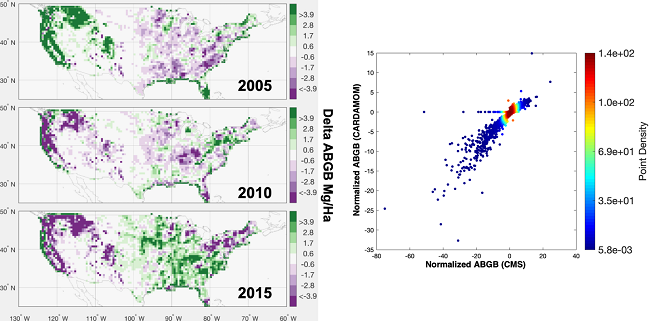The ORNL DAAC recently released the following new Carbon Monitoring System (CMS) dataset by Yang, S., et al. (2021):
CMS: Terrestrial Carbon Stocks, Emissions, and Fluxes for Conterminous US, 2001-2016
This dataset provides estimates of carbon pools, fluxes, and associated uncertainties across the contiguous USA (CONUS) at 0.5-degree resolution for all terrestrial land cover types. Carbon pools include labile carbon, foliar carbon, fine root, woody carbon, litter carbon, and soil organic carbon. Carbon fluxes include gross primary production (GPP), net primary production (NPP), net biome exchange, autotrophic respiration, and heterotrophic respiration. The modeled estimates are provided as monthly averages over the 16-year period, 2001 through 2016. The data were derived from the CARbon DAta MOdel fraMework (CARDAMOM) that included climate data, and above and below ground biomass maps of CONUS for the years 2005, 2010, 2015 and 2016 as input data sources to this model-data fusion framework. The input data were integrated into the CARDAMOM model to constrain on the terrestrial carbon and to specifically attribute changes of forest carbon stocks and spatial distributions of carbon emissions and removals across forested lands. United States Forest Service's Forest Inventory and Analysis (FIA) plot data were used to train models for the prediction of forest above-ground biomass (AGB).
The NASA CMS program is designed to make significant contributions in characterizing, quantifying, understanding, and predicting the evolution of global carbon sources and sinks through improved monitoring of carbon stocks and fluxes. The System uses NASA satellite observations and modeling/analysis capabilities to establish the accuracy, quantitative uncertainties, and utility of products for supporting national and international policy, regulatory, and management activities. CMS data products are designed to inform near-term policy development and planning.
Additional data from CMS and other relevant links can be found on the ORNL DAAC's CMS Project Page.
Citation: Yang, Y., and S.S. Saatchi. 2020. CMS: Terrestrial Carbon Stocks, Emissions, and Fluxes for Conterminous US, 2001-2016. ORNL DAAC, Oak Ridge, Tennessee, USA. https://doi.org/10.3334/ORNLDAAC/1837

